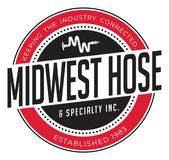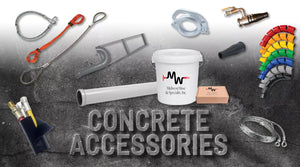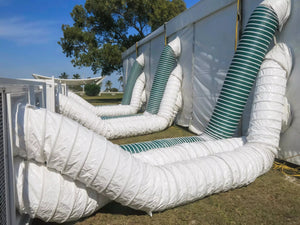Hose Measurement and Selection
How do I measure my hose?
Due to expensive shipping costs, our duct hoses ship compressed (See image for reference). Shipping ducts in a compressed state allows us to ship hoses at a rate that fair and saves our customers money. Compressed duct hoses can seem as much as three feet shorter than the length ordered. However, we promise that your hose is the length you ordered.
To properly and accurately measure your new hose right out of the box you will need the following:
- Measuring Tape
- Masking Tape
- At Least Two People
Step 1: Use the measuring tape to measure the full length of your new hose on the ground.
Step 2: Place a piece of tape on either end of the measuring tape. The distance between each piece of tape should represent the full length of your duct.
Step 3: With a person grabbing either end of the hose, pull the duct till it has reached both sections of masking tape.
How can I make sure I get the right hose?
Midwest Hose offers a variety of hose types to consumers each with unique benefits and uses depending on your specific needs. Below is a guide to assist you in determining the correct hose for your application. Choosing the right flexible hoses starts with choosing the right hose types.Look through our full catalog to see which type of ducting is best suited for you. And if you are unsure, please give us a call. We are ready to help you find what you need.
How do I understand the Midwest Hose SKU's?
Following the diagram linked below, you can look at our parts list and know which type of hose you are seeing at a glance. It will tell you the duct type, the color, wearstrip color, pitch, end connectors, the duct ID, and the length. If you are uncertain, our staff can help you identify the correct part for your job application.
View diagram
Concrete Products
What are hazards of concrete hoses?
Hose whipping occurs due to the entrapment of air within the delivery system, which can happen during concrete pumping operations or while cleaning out the line. This phenomenon becomes particularly violent when air enters the line and is pressurized by the pumping process.
Air may enter the delivery system under various circumstances:
- When the pump is initially started
- Upon restarting after relocation
- When the concrete level drops below the valve
- When the pump operates faster than concrete delivery
- When the pump continues operating after complete discharge
- When a blockage is cleared
- Due to poor maintenance of the hose
- When concrete free-falls after the pump is turned off.
Selecting appropriate equipment and implementing safe work practices can diminish the risk of hose whipping, while additional measures for risk control can further reduce the likelihood of injuries.
Why is it important to choose the right size and length hose?
The selection of hose size and length for concrete pumping is not arbitrary; rather, it directly impacts the safe and efficient operation of your pump. Utilizing hoses that are correctly sized and tested is crucial for achieving the desired output in terms of yards pumped per hour, and it ensures that the pump operates at its maximum capacity, particularly concerning the diameter of the largest aggregate being pumped.
Opting for the most suitable hose length necessitates thoughtful consideration of the following elements:
- The capabilities of the pump, encompassing the pumping rate and line length.
- The maximum size of the concrete mix concerning the diameter of the line.
- The dimensions of the material cylinder, both in terms of diameter and length.
By meticulously evaluating these factors, you can attain peak performance and enhance efficiency in your concrete pumping operations.
What is the difference between textile and wire concrete pumping hose?
Regarding reinforcement, concrete pumping hoses can be classified into two main types: textile and steel reinforced. Textile hoses utilize a woven fabric reinforcement, often made of synthetic materials, whereas steel-reinforced hoses employ metal wires for reinforcement.
Textile hoses, although they provide improved safety, efficiency, and productivity, may be prone to hose-whipping, a dangerous situation during pumping activities. On the other hand, steel-reinforced hoses, known for their durability, versatility, and effectiveness in concrete placement, may face challenges such as clogging with debris, accelerated wear due to abrasive materials, and corrosion.
How do I maintain my concrete hoses?
The durability and performance of your concrete pump hose hinge greatly on its maintenance practices. Regular inspection, appropriate storage, and handling, along with timely replacement, all play pivotal roles in ensuring optimal hose longevity.
For effective maintenance, conducting a daily inspection of all connections before pumping is essential. Visual checks for cracks, dry-rotting, leaks, particularly at the fittings, are vital steps to ascertain the hose's durability and performance. Storing the hoses in a cool, dry area shielded from direct sunlight is recommended to prevent degradation and extend their lifespan.
Regular Inspection
To maintain your concrete pump hose effectively, regular inspection is indispensable. This not only aids in early detection of damage but also ensures the hose operates at its peak performance.
Identifying visible cracks, tears, softening, or deterioration of the hose material, as well as leaks or abrasions during routine inspections, is crucial for ensuring safe and efficient operations.
Proper Storage and Handling
Extending the life of your concrete pump hose largely depends on proper storage and handling techniques. Storing hoses in a dry location, away from water sources and sunlight, is advised. Utilizing raised-end fittings and appropriately adjusted clamps can offer additional protection during storage.
When handling concrete pump hoses, it's vital to:
- Place them gently on a supporting cradle
- Maintain a safe distance when they are pressurized
- Use personal protective equipment during handling
- Avoid inappropriate usage
Adequate training and careful handling are essential to prevent damage during operations.
How do I know when to replace and dispose of concrete hoses?
Knowing when to replace your concrete pump hose is as crucial as maintaining it. Visible signs of deterioration such as cracks, abrasions, leaks, or any other damage indicate the need for replacement. It is recommended to replace the hose every six weeks or after approximately 250 hours of use.
When disposing of hoses, removing residual concrete, and repurposing the material for new construction projects, it is important to adopt a sustainable approach. Additionally, collecting and recycling the wash water and solids from cleaning the hoses contributes to waste reduction and sustainability in the industry.


